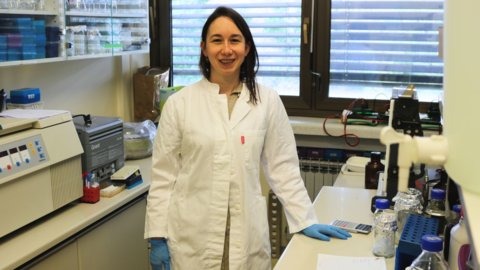A research team led by Dr Ivana Brekalo at the Ruđer Bošković Institute (RBI) is breaking new ground in the sustainable synthesis of porous materials that capture carbon dioxide while avoiding harmful solvents.
Each day, significant amounts of carbon dioxide (CO2), a by-product of burning fossil fuels, are released into the atmosphere, significantly influencing climate change. Imagine if we could "capture" this CO2 directly from the air, similar to how trees operate. For these and other applications, substances known as porous materials are essential. Dr Ivana Brekalo and her team at the IRB's Laboratory for Sustainable and Applied Chemistry are at the forefront of innovative research in this field.
The challenge is daunting because we need unique materials that can "grab" CO2 molecules from the air and store them safely, like molecular sponges. These porous materials are interspersed with tiny cavities that can hold gas molecules. However, their production is anything but simple.
"For most materials, their function is directly linked to their molecular or atomic structure, which in turn determines their properties. Unfortunately, predicting the structure of materials - especially soft, molecular materials — is often a difficult endeavour. Therefore, we usually rely on extensive experimental studies guided by chemical intuition," explains Dr Brekalo.
This approach is inherently unsustainable and wastes large amounts of reagents, energy and time on experiments that are pointless at best. In addition, most current synthetic methods are solvothermal and require large amounts of potentially hazardous, toxic and expensive solvents that ultimately become waste and must be handled with kid gloves.
Ironically, in our endeavour to solve environmental problems, we are inadvertently creating new ones.
Dr Brekalo and her team, however, are taking a different approach. Instead of relying on solvents, they rely on mechanochemistry — a method in which chemical reactions are triggered by mechanical force, similar to grinding coffee. Just as ground coffee beans yield a faster cup than whole beans, ground raw materials react more quickly and easily to deliver the desired products.
This method requires no harmful solvents and is faster, safer and more energy efficient than conventional methods. With several groups working on cutting-edge mechanochemistry, the IRB is a world leader in this field.
Dr. Brekalo's team has gone one step further and combined mechanochemistry with advanced computational methods to predict which combinations of starting materials and the resulting materials will be most effective. This approach, known as Computational Aided Mechanochemical Templating (CAMT), drastically reduces the time and resources required to develop new materials.
Porous materials have a tendency to collapse
The discovery of new materials becomes even more difficult when dealing with porous materials whose properties depend on the exact size, type and shape of the voids in their structure. It is like building a house of cards with large halls and narrow passages that collapses at the slightest touch. Similarly, porous materials have a natural tendency to "collapse" and lose their valuable cavities.
To prevent this, Ruđer's team uses an approach that focuses on special molecules that act as "templates" - molecular scaffolds that act as guests in the structure of porous materials, stabilising them through intermolecular interactionsand thus preventing the porous structure from collapsing.
These templates not only prevent the porous material from collapsing in on itself, but also limit the possible structural landscape of porous materials and ensure that only the desired structures are created, similar to a scaffold before the bricks are laid and the walls are built.
In addition, these templates can give the material special properties — they can make it magnetic, accelerate chemical reactions or even enable it to react to light.
Although this all sounds promising, there is a catch. We still can't predict which molecules will be suitable as a template for a particular structure. It’s a bit like guessing which pillars will best support the house of cards without a blueprint or calculations, so you're forced to try each one out to see which one holds up best. Dr Brekalo's team hopes that their CAMT approach will reduce the number of possible templates, making it quicker and easier to discover new materials that meet the growing demands of our society.
Broad Applications and Scalability
The potential applications are diverse and range from agriculture to the high-tech industry. Crucially, this approach can easily be scaled up to an industrial level. "The equipment required to scale up mechanochemistry is already widely available in the local Croatian industry," emphasises Dr Brekalo.
"Extruders are used for the production of polymers and in the food industry, while drum mills are widely used in the cement industry on a tonne scale. Synthesising high value-added products through mechanochemistry would catapult us to the forefront of global sustainable development and bring great benefits to our economy without harming our environment or population."
The potential applications of this research are diverse — from capturing CO2 from the atmosphere and storing hydrogen as a clean fuel to producing more efficient catalysts for industrial processes. This could significantly support global efforts to combat climate change and develop more sustainable technologies.
The work of Dr Brekalo and her team is an example of how cutting-edge scientific research can be both efficient and environmentally sustainable. Their pioneering approach not only accelerates the discovery of new materials, but also significantly reduces their environmental footprint, setting new standards in the field of sustainable materials development for the future.




